Jeanne Haas, née Ulmann
Photo from the Shoah Memorial in Paris
Introduction
Have you ever wanted time to pass more quickly? For our class, the answer was a resounding yes. It used to happen to us all the time in history class. We had covered many topics, Antiquity, the Middle Ages, Modern Times, but none of them had succeeded in relieving our feeling of boredom with the subject. This remained the case until one day, Mr. Tschopp, our history teacher, told us about the “Convoy 77” project. When he explained what it involved, our whole class was immediately enthusiastic about it and decided to take part in it.
Aboard the convoy were some people from Switzerland, and that caught our attention. The most astonishing thing for us was that one of the passengers came, like us, from Delémont, the city and region where we live. We decided immediately to research the life of this woman, Jeanne Haas, née Ulmann.
Switzerland being a neutral country, we had always imagined, until now, that the Swiss people had been spared, and that the war had stopped at the border. We had never given it any further thought. This project has opened our eyes. We have realized that these wars were not called World Wars for nothing. Regardless of our background, our mother tongue, our skin color and our religion, we have all been touched in one way or another by these tragic events.
In our view, all of the war victims died for no good reason. Left without any kind of protection, they were not safe anywhere. Constantly under the threat of death, they simply waited for time to pass, for days to pass, for years to pass, and for the war to finally end.
Today, our generation attaches great importance to its own, often trivial, problems, which are incomparable to those encountered by one segment of humankind. We have never felt such a sense of anticipation and fear. Writing this biography helped us to realize this.
We find it hard to imagine that such atrocities could have been committed on this planet. How could it have come to this? We have been unable to find any answers to this question, and we do not know if we shall ever find any. We humans all share the same planet. We live together. That should be enough to ensure that no one dares to harm anyone else.
We hope that by writing these words we will be able to honor the memory of all the women and men who died so unjustly during the war. No one must ever forget them. There will soon be no more survivors left from that time, so it is our duty to share their stories. Paying tribute to these people who were our ancestors, our families, these people who lived through the worst of times seems natural to us today. Historians are all interested in important events and in famous people, but few have paid any attention to a person who was nothing special, yet endured these tragic events. That is exactly what this project achieves. In writing the biography of Jeanne Haas, we took an interest in someone ordinary. This woman did not change the course of history. She was not the leader of a rebellion, nor was she a soldier in the army, but she was there nonetheless. She lived during the war, she lived through all these horrible events. We have often used the third person plural because Jeanne and her daughter Éliane lived, as one can imagine, all these events in unison and, for some of the time, in the same body.
These months of research have been incredible. The whole class worked hard to achieve our goals and complete the biography of Jeanne Haas. Each classmate has been helpful in their own way. We have had some unforgettable moments, some amazing evenings, and we will definitely have more in the future, that’s for sure. This research has helped us to grow. We have started to approach history from a different perspective. We weren’t in class or reading our books, we were working like historians, deciphering records, trying to find connections and cross-referencing, sometimes heading off on the wrong track. It was like detective work. We had to accept rejection. And above all we had to learn to work as a team. We are thus submitting a biography that could still be improved upon because we were unable to use all of the information in the documents. There are still a few grey areas in Jeanne Haas’ life story, but we assure you that we have all put our heart and soul into it.
As Oscar Wilde said “Shoot for the moon. Even if you miss, you’ll land among the stars.” So we are aiming for the Moon, and we want to add even more emphasis to this project and to prolong the story in different ways, through meetings, trips and so on. With a bit of luck, we might even make it to Paris. But no matter the outcome, we will have had the chance to participate in this project, to get to know Jeanne Haas and retrace her life.
In order to make this biography even more realistic, we aim to follow in the footsteps of Jeanne Haas and relive her life, that is to say, to start from Delémont and arrive at Auschwitz. This will no doubt be and unforgettable experience. In addition, we are working towards having a street in Delémont named “rue Jeanne Ulmann-Haas”. We would also like to bring to our school a person who lived through this period to give an account of their experience to the students. Finally, we would like to have an artist or some students from our area illustrate the biography in its entirety. And we might have other ideas in future too.…
Our projects might not all come to fruition, but we are determined to accomplish as much as possible to make sure that Jeanne Ulmann-Haas will never be forgotten.
We are proud to present the biography of Jeanne Ulmann-Haas.
The students of class 11e2 at the Delémont junior high school.
“If the echo of their voices fades, we shall perish”
Paul Eluard
Childhood in Switzerland
It all began in 1874 when Isaac Ulmann, son of Daniel Ulmann and Eve Ulmann, left Alsace for Delémont, in Switzerland. Delémont was then in the canton of Bern, but is now the capital of the canton of Jura). He was of Jewish faith.
From 1850 onwards, the number of Jewish people in Delémont increased. Before the Synagogue was established in Delémont, the Jews used to meet at the Orangery, in the gardens of the Castle. In 1850, there were about 36 Jews in the area.
When it was founded in 1911, the synagogue was attended by about seventy Jews, most of them originally from Alsace, mainly tailors, textile merchants, and cattle merchants. Since 1970, religious worship has not been possible there however, because there are no longer enough men people to lead it.
In June 1999, seven people, including representatives of the Delémont council and churches, founded a Foundation for the preservation of the synagogue.
The Delémont synagogue continues to make its presence known in the Jura town and through the footage by the film director Franz Rickenbach in “A synagogue in the Hills”, a documentary that pays tribute to the community that has influenced the history of our city.

“Delémont Synagogue in 1900, source: Chappuis-Fähndrich museum in, Develier, Switzerland”
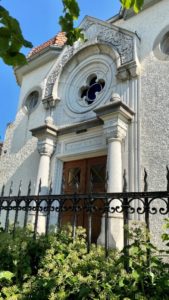
“The Delémont synagogue today, personal photos”
When he arrived in Delémont, Isaac’s plan was to open a branch of his father’s store called “Les Fils de Daniel Ulmann”. It was foodstuffs, fabrics and textiles business. His store opened its doors on September 1, 1874, on rue du Cheval Blanc.
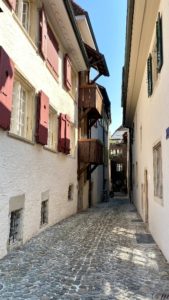
“Rue du Cheval Blanc today, personal photo”
In the year 1876, Isaac Ulmann married Fanny Goetschel, who was the daughter of Joseph Goetschel and Marie-Anne Goetschel. A few years after their marriage, Jeanne Ulmann was born, on April 1, 1879 in Delémont. She was Jewish (the term used in the archives is Israelite), as was the rest of her family.
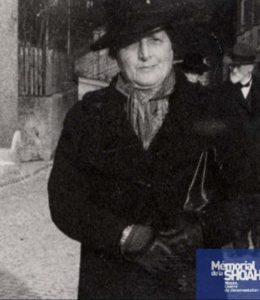
“Jeanne Ulmann-Haas, source : The Shoah Memorial”
This woman was born in Delémont. She walked in the same places, saw the same buildings and trod the same streets as us. She just didn’t live the life she deserved. She could have lived a perfectly normal life if she had been born at a different time.
A walk in Delémont
Jeanne,
You lived in Delémont, like most people in our class. And it is that which prompts me to write this little letter to you now. As I contemplate the streets of Delémont today, my thoughts are focused on your footsteps in these very streets.
You probably went along the Rue du 23-June and passed in front of the City Hall, as I sometimes do on my bike. You too may have been able to go into the Château de Delémont, my old school.
Unfortunately, you didn’t stay very long in Delémont because you soon went to La Chaux-de-Fonds and then to Alsace. But I’m sure you were able to admire our beautiful old town in all its splendor.
“Letter written by Luc Koller, a student in our class, to Jeanne Haas”
She was to have two brothers, Adolphe, born in 1883, and Sylvain, born in 1888. According to our research, the family lived on rue de Fer in old town center of Delémont.
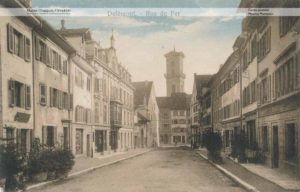
“Rue de Fer Delémont in 1900, source: Chappuis-Fähndrich museum in, Develier, Switzerland”

“Rue de Fer Delémont today, personal photo”
Jeanne spent a large part of her childhood in Switzerland. After Delémont, the family lived for some time in La Chaux-de-Fonds, in the canton of Neuchâtel. At the end of the 19th century, probably before 1890, she left for Mulhouse, in the Alsace region France. She married Paul Haas, son of Lazare Edouard Haas and Rosine Dreyfus Haas, and thus became Jeanne Ulmann-Haas. We do not know if they were married in Switzerland, or later on, in Alsace.
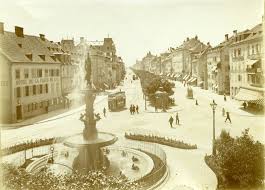
“La Chaux-de-Fonds in 1900, source: CdF–bibliotheque-Ne”
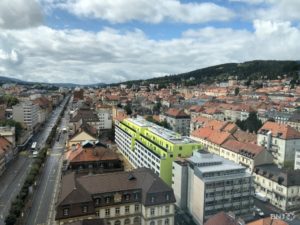
“La Chaux-de-Fonds today, source: Rtn”
Life in Alsace
When the Haas family arrived in Alsace, the region was German; in fact, ever since the Franco-Prussian War of 1870, Alsace had been part of the German Empire.

“Mulhouse 1900, source: la vie à Mulhouse”
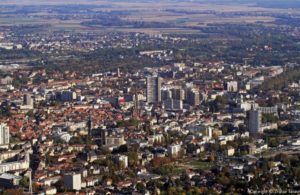
“Mulhouse today, source: Survol de la France”
German was spoken as the official language, with permission to use French as the government administration language. Paul and Jeanne Haas lived at 24 Schulstrasse (currently rue Henriette).

“Rue Henriette, Mulhouse in 1900, source: Ebay”
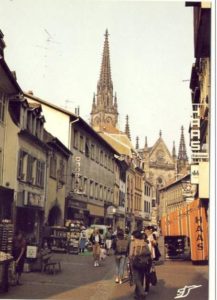
“Rue Henriette, Mulhouse today, source: lavieamulhouse”
The couple had three children: Susanne, Andrea and Éliane. The eldest of the siblings, Susanne, born in 1900, would later marry a certain Julien Dreyfus and then, in 1924, an Armand Guggenheim. Robert Dreyfus, a child of the first marriage, submitted a research request after the war for his grandmother, Jeanne Haas.
Andrea was born in 1905, by which time the family had moved to 51 Rue des Trois-Rois. Their last child, Éliane, was born in 1918, at the end of the First World War, just four months before the armistice.

“Éliane Haas, source: The Shoah Memorial”
The Treaty of Versailles, on June 28, 1919, stipulated that the people of Alsace-Moselle be automatically be granted French nationality. The Haas family was living Alsace, and thus they became French citizens once again.
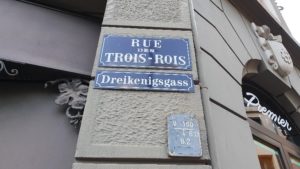
“Rue des Trois-Rois in Mulhouse today, personal photos”
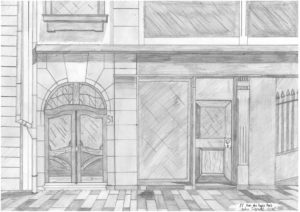
“51, rue des Trois-Rois, Mulhouse, drawing by Jules Gigandet, a student in our class”
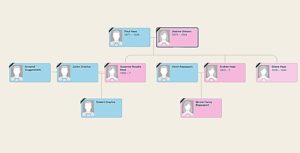
“An attempt to reconstruct the Haas family tree, myheritage“
Paul Haas, Jeanne’s husband, ran a shoe business called “Au caprice Paul Haas” (At the whim of Paul Haas). When her husband died, Jeanne Haas renamed the store “Les chaussures Paul Haas” (Paul Haas Shoes). The family had been in the shoe business since 1868. It was in this store that Jeanne worked for a significant period of her life. Even though the address has changed, the business still exists and it seems that there is a link between Paul Haas’ family and that of the current owners. It now belongs to Jeanne Haas’ presumed grand-nephew, Mr. Gros. After the war, the business was taken over by Rosine Haas-Lévy, Paul Haas’ sister. This woman had four children, including Jeanne Lévy-Gros, who in turn took over the store, together with her husband, and ran it until 1990.
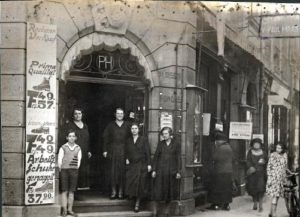
“The Paul Haas Mulhouse store, most likely with Jeanne Haas (top left) and her colleague, in 1921, source: lavieamulhouse”
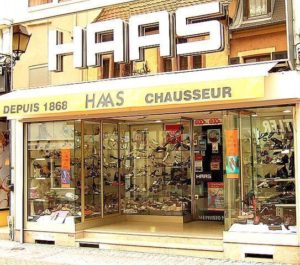
“The Haas store today, source: vitrinesdemulhouse”
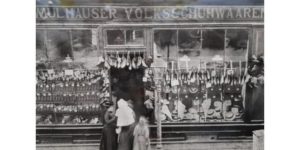
“Paul Haas store, source lalsace”
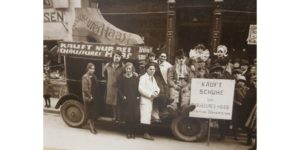
“Paul Haas store in 1900, source: lalsace”
The family enjoyed a fairly comfortable life in Mulhouse and included some prominent people. Paul Haas was in fact a municipal councilor in the Socialist party, which gave him a certain social status.
The period between the two world wars was characterized mainly by the emergence of a series of “totalitarian” regimes: Stalinism in the communist USSR under Stalin, fascism in Italy under Mussolini, and Nazism in Germany under Hitler. Democracy was undermined. These new, terror-based regimes relied on constant oppression everywhere: opponents were arrested and sent to camps. These regimes were also centered around hero-worship of their leaders, and statues and places were built in honor of these people. Lastly, there was widespread use of propaganda and censorship.
In Germany, Hitler had been in power since 1933. He was appointed Chancellor by President Hindenburg. He arrived almost like a savior after very difficult years from an economic and social point of view, the 1929 crisis having only exacerbated the situation in Germany. Adolf Hitler was born in Austria in 1889 and after drifting for a few years, he joined the German army as a volunteer in 1914. In 1920, he joined a marginal nationalist party and membership numbers grew rapidly. He tried to seize power in a coup d’état but was arrested and sent to prison. He spent a year in jail, where he worked out his strategy for returning to politics in the future. As soon as he came to power, he pointed the finger at the Jews, who were supposedly to blame for all of Germany’s misfortunes; they were his scapegoats. About six million Jews were murdered during the Second World War. On April 30, 1945, when Germany had to concede defeat, Adolf Hitler committed suicide in his bunker.
On Tuesday, August 21, 1928, in the period between the wars, Paul Haas got sick and died. He was apparently highly regarded in Mulhouse, as the entire city council met to pay tribute to the deceased. Jeanne Haas thus became a widow and had to take care of her youngest daughter, Éliane, who was ten years old at the time of her father’s death.
After Germany suddenly invaded Poland, France and the United Kingdom declared war on Germany. Germany then went on to attack Denmark, Norway, Luxembourg, Belgium, the Netherlands. Then in May 1940, after a waiting period that became known as the “phoney war”, Germany went on to attack France.
On May 10, 1940, Germany attacked France from the west. The French and British commands expected the German army to attack from the center of Belgium (as had happened in World War I). The “Wehrmacht”, however, began its invasion in the Ardennes, and German tanks and infantry troops broke through the French lines and made their way right across France to the Atlantic coast.
France acknowledged defeat, and capitulated. Hitler took his revenge for the First World War and the humiliating Treaty of Versailles. Nazi Germany then divided France into two zones: the north of France was in the occupied zone and the south of the country in the free zone.
As for Alsace, the Germans asserted that it belonged to them; it therefore became part of the Third Reich and as soon as they arrived, they began to expel “undesirable people”, in particular the Jews.
In 1940, on July 15 to be precise, Jeanne and Éliane Haas were expelled from Mulhouse. Mother and daughter thus had to leave Alsace in great haste, taking with them only the bare necessities and 2,000 francs in cash. They were forced to leave almost everything behind, after having invested so much in their adoptive city. All of those expelled, about 45,000 in total, also had to sign a declaration in which they undertook never to return to Alsace. Jeanne and Éliane Haas thus moved to Lyon, which was in the free zone, probably because they had family and/or friends there.
Alsace was annexed by Nazi Germany in 1940, following the Battle of France, in breach of the June 22nd armistice agreement signed by France and Germany. In 1940, the town of Mulhouse, along with the rest of Alsace, was annexed into the Third Reich. On 18 June 1940, at about 8 a.m., 30 or so men arrived in Mulhouse, which had been declared an open city. The French flag on the town hall was replaced by a swastika. The Occupation had begun. On June 20, Hitler’s troops marched into Mulhouse. Alsace became part of Baden country and the German authorities took over from the French. This led to numerous changes: the Nazi party oversaw, monitored and controlled the population and “Germanization” began to take effect. The people were forbidden to speak the French language and to wear berets and French books were burned. Then came the Germanization of surnames, first names and place names. Then August 24, 1942, compulsory military service was introduced for the men of Alsace, the so-called “malgré–nous” (“in spite of ourselves”, or “against our will”).
Exile in Lyon
Jeanne and Éliane Haas moved to Lyon, a city that was in the free zone at the time. They lived there for four years, at 212, rue Paul Bert. Éliane worked as a sales assistant.

“Rue Paul Bert, Lyon 1900, source: Geneanet”

“Rue Paul Bert, Lyon today, source: Wikipedia”
During the Second World War, Lyon played an important role in French history. Like other cities, Lyon had been preparing for war from 1939 to 1940.
Lyon, which was in the free zone until 1942 and very near the demarcation line, was a major resistance stronghold and therefore welcomed refugees. After November 11, 1942, when the Germans invaded the southern zone, Lyon faced severe reprisals, partly due to the strength of the local resistance movements and partly because it was the regional capital of the Gestapo, the SS, the Feldgendarmerie (military police), and for the French Militia. There were also numerous roundups. At the end of 1942, the population lost confidence in the Vichy government and experienced almost two years of severe deprivation until the Liberation. Attacks and sabotage were daily occurrences in 1943 and 1944.
The resistance movements protected the city and in return suffered many losses, including the arrest of some key Resistance members, such as Jean Moulin. The city was subsequently liberated on September 3, 1944 by the American army and French forces, who landed in Provence on August 15, 1944.
Jeanne and Éliane Haas therefore lived in an atmosphere permeated with fear and hope during their years in Lyon, and they were arrested only six weeks before the city was liberated.
Expelled from their homes, far from their families and far from their homes, without anyone ever having asked their opinion, Jeanne and Éliane Haas then became prisoners of the Nazi Germans..
I was shocked to hear your life story
And as the subject our biography, we chose you
Living through that was certainly not easy
We found your family members
We retraced your journey
And I wrote down your life
Poem written by Thalia Sommer, a student in our class
Deportation
On July 13, 1944, Jeanne and Éliane Haas were arrested at their home by the Gestapo. Their only “crime” was that they were Jewish.
The Gestapo, an acronym taken from the German word for “secret police,” was the political police force of the Third Reich. It was synonymous with terror and arbitrariness on account of its activities. It played an instrumental role in the extermination of the Jews in Europe and was condemned as a criminal organization at the Nuremberg Trials.
They were taken to Montluc prison, in the 3rd district of Lyon. They remained there for about ten days. Perhaps they crossed paths with the “executioner of Lyon”, Klaus Barbie, who was tried and imprisoned for his many crimes in 1987, after being detained in South America, where he had taken refuge at the end of the Second World War.

“Montluc prison in 1900, source: linflux”
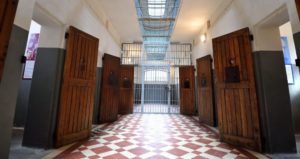
“The interior of Montluc Prison today, source: Franceinter”
The two women were then transferred to Drancy camp on July 24, 1944. They stayed there for a week before being sent to the Auschwitz extermination camp.
Drancy camp was opened in August 1941. It was located northeast of Paris, in the town of Drancy, and was closed three years later in 1944.
For three years, Drancy was the principal internment camp for those who were to be sent to the Nazi extermination camps, mainly Auschwitz.
Nine out of ten Jews deported from France passed through the Drancy camp during the Holocaust.
Before becoming a camp, Drancy was a low-cost housing estate. It was only later, in 1940, that it became an internment camp.
The Germans requisitioned the buildings on June 14, 1940, in order to use it as an internment facility for prisoners of war.
From 1941 onwards, the internment camp became an internment and retaliation camp. This change came about following the major roundup carried out in Paris on August 20, 1941, when a total of 4,230 men were transferred to Drancy camp..
In the fall of 1941, the first prisoners in the camp suffered from starvation. At the end of October, 40 people died.
By way of food, the prisoners only had soup, served in large stockpots brought to their dormitories.
Hygiene conditions were appalling. The children had lice. There was a laundry service, but the internees preferred to keep a change of clothes with them for fear of being deported without their belongings.
The washrooms were located near the entrance to the camp, in a red brick room, nicknamed the “red castle”. The Jews could only use the bathroom at set times. It was in the red castle that the prisoners met and discussed the latest rumors. In 1942, a spate of suicides took place among the internees. With the arrival of the SS in June 1943, terror descended on the camp, but it was also modernized somewhat. Living conditions improved a little as a result, but in reality, the sole purpose of this work was to better organize the deportation of Jews to Eastern Europe.
While still under French control, the camp became a huge marshalling yard, and cattle cars crammed with inmates were sent to Auschwitz.
Early in the summer of 1944, as the Allied forces were advancing, thousands of Jews from towns further south were sent to Drancy for deportation. The deportees were taken to Bobigny train station. A Nazi called Alois Brunner had been in charge of the camp for a year. As they left, his men burned many of the camp records, but two internees manage to save the list of names. The camp was then entrusted to the Resistance. On August 20, the last internees were freed.
Drancy then fell into oblivion until an American photographer discovered cells and torture chambers in the basement (which, incidentally, made it possible for Drancy to be classified as a historical monument). Discovered by chance during housing renovation work in 1989, graffiti in chimneys and in “prison cells” in the basement had been drawn side by side, by both suspected collaborators and by Jews. They had all, in their turn, made a record of their internment by writing their first and last names and the date of their imprisonment, in pencil or chalk, on the bricks and concrete in the prison basements. Children, single men and women, even families: many of them wanted to leave some personal mark, their name, a poem, a drawing “for posterity”.
Along with two other “deportees”, Éliane Haas left a moving message there (see photo below).
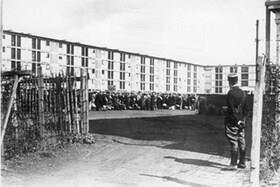
“Drancy camp, source: Swissinfo”
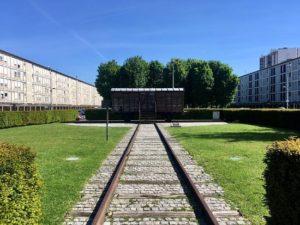
”Drancy camp, source: Tripadvisor”
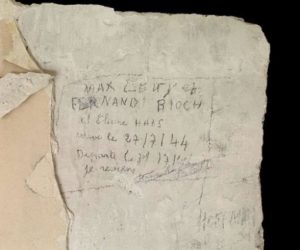
“Graffiti found inside a building in Drancy, source/ French National Archives at Pierrefite”
On July 31, 1944, the two women left Drancy aboard Convoy 77, bound for the infamous Auschwitz camp. They were among the 986 men and women, accompanied by 324 children, all deported on the last of the large convoys to leave Drancy for Auschwitz.
They traveled for three days in cattle cars, crammed in together with other deportees. Deprived of food and water, they had to stand for most of the trip. They arrived at Auschwitz-Birkenau between August 3 and 5, and some people did not survive the journey. On arrival, the deportees were separated into two lines. One line was sent to do forced labor, the other straight to their deaths in the gas chambers.
We do not know exactly what happened to Jeanne and her daughter when they arrived at the camp. A document in the archives records a last-known sighting on November 10, 1944. Perhaps they died of sickness, starvation, fatigue or mistreatment at the hands of their torturers. In any event, Jeanne Haas’ death was officially recognized by a Mulhouse court decision in 1949 (the court having noted that she had never returned) following a request made by her grandson, Robert Dreyfus. The date of her death was then determined to be August 4 or 5, 1944 (official documents differ), when the convoy arrived, five days after it left Drancy. Whether she died a few hours later or some time afterwards, we may never know. As for Jeanne’s two sisters, they did not meet the same fatal fate; fortunately, they were spared all these atrocities.
The Auschwitz camp was the Third Reich’s largest concentration camp. It was opened on April 27, 1940 by Heinrich Himmler. It covered an area of more than 21 square miles (55 square kilometers). It was made up of three camps. The first, Auschwitz I, which opened on May 20, 1940, was the main camp. Initially, it housed Polish and Soviet prisoners of war and political opponents, then later for Jews and resistance activists of all nationalities.
It was in this camp that in 1941 Zyklon-B gas was tested on the prisoners. The camp included a gas chamber and a crematorium, with three furnaces. It was also here that Nazi doctors carried out horrific “medical” experiments. The second camp, Auschwitz II or Auschwitz-Birkenau, opened on October 8, 1941. It was used to exterminate Jews and Gypsies. To achieve this, the Nazis built four gas chambers and crematoriums, where more than a million people were killed. The third camp, Auschwitz III or Auschwitz-Monowitz, opened on May 31, 1942 and was used to house working prisoners.
The chances of survival in these camps were almost nil. The deportees arrived by train; 900,000 people were killed on their first day, upon arrival. In addition to the methods used deliberately by the Nazis, many prisoners died of malnutrition or disease, due to poor sanitary conditions.
Auschwitz was finally liberated on 27 January 1945 by the Red Army. In total, more than one million one hundred thousand men, women and children died there.
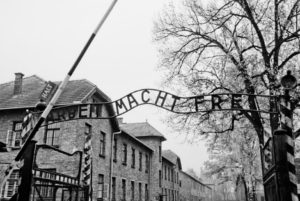
“Auschwitz in 1940, source: lexpress”
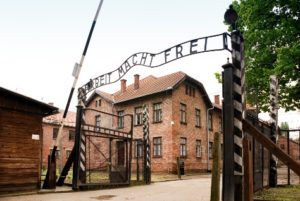
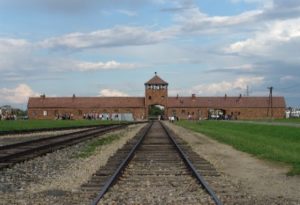
“Auschwitz today, source: Tribune de Genève”
Closing remarks
So ended the life of Jeanne Haas, and with it our work also comes to a close.
We hope that reading this biography reflects our enthusiasm and interest in writing it. What an incredible opportunity to be part of this venture! With a little pride but also much humility, we are happy to be the only current representatives from Switzerland in the “Convoy 77″ project. Nevertheless, our eyes remain focused on our homage to this native of the Jura, Jeanne Haas. Although there are still some grey areas in her personal history, we have tried to retrace her life as best we can. We have lived with her, and through her, in a way. We hope that Jeanne Haas is watching us, wherever she is, with a little happiness in her eyes.
Thanks to the “Convoy 77″ project, thanks to this biography and thanks to Jeanne Haas and her daughter Éliane, our work has been an enriching experience in many ways. We have learned many things, and we may go travelling, but above all we have enjoyed our history classes. We could not have dreamed of anything better for our last year in school. As we move on gently towards various training courses, this experience will have brought us knowledge, a glimpse into the past, teamwork and solidarity. We have also discovered unspeakable horrors, the consequences of which we have inherited. It is up to us now to prevent this from happening again, be it on a small or large scale. This is the most beautiful gift we could imagine.
We would like to thank our teachers, Julien Tschopp and Marilyn Fazio, who pushed us and motivated us to carry on. They never gave up and none of this would have been possible without them. Thank you to all the students of this class, thank you to Amélie, Aymeline, Chloé, Elena, Gaëtan, Isabella, Jules, Kali, Kalyssa, Luc, Mathieu, Thalia, Timo and Zaira. We are proud to have reached this point.
We would like to address our final few words to Jeanne Haas herself: may our work be a fitting tribute to you, worthy of the courage you had to show all throughout your life.
Delémont, October 9th, 2020
Dear Jeanne,
It has been a good few weeks now since we got to know you, to retrace your life, sadly so tragic and so moving.
From your birth in Delémont, to your move to La Chaux-de-Fonds and then your life in France, where you might have imagined a happier future. But that was before the terrible upheaval that the Jewish community experienced. We can only imagine the horror, the terrifying moments and the anguish that were part of your life. The things that you and everyone else involved went through, you didn’t deserve that.
Looking at your photo, we initially felt great sadness and frustration. We knew the horror you had experienced…
Then, the bond was formed almost naturally. With every new piece of information about you, we connected with you in some way. So today, when we see your picture, a feeling of complicity and friendship develops within us. You look so warm, so kind.
By carrying out this project and taking an interest in the subject, we would like to pay you a worthy tribute and tell your story to the world, so that you will never be forgotten. We hope that we have somehow given you back a little bit of life, so that you will never be forgotten again.
In the hope that you are now resting peacefully wherever you are …
We wish you well
Amélie, Aymeline, Chloé, Elena, Gaëtan, Isabella, Jules, Jules, Kali, Kalyssa, Luc, Mathieu, Thalia, Timo, Zaira
“If the echo of their voices fades, we shall perish.”
Paul Eluard
With thanks to:
- the various archivists who helped us in our research, especially to Ms. Michelon at the Mulhouse archives department.
- the genealogists who have also accompanied us in our discoveries and who sometimes shared important findings with us. We are thinking of the members of the CGAEB, Mr. Etique and in particular Mrs. Dapozzo for her various contributions throughout her research.
- Claire Podetti, for contacting us and convincing us to participate in the project, and also for her frequent explanations and encouragement, and to Serge Jacubert for his help.
- the Jewish community of Haut-Rhin, who gave us information, contacts and leads, as well as the Association of the Friends of the Synagogue of Delémont, and Ms. Becker.
- Ms. Tridon, documentalist at the Lambert High School in Mulhouse, for her work with the students and for carrying out various pieces of research.
Sources:
- “La communauté israélite de Delémont aux XIXe et XXe siècles”, François Kohler, Fondation Synagogue de Delémont, Association des Amis de la Synagogue de Delémont.
- Various Wikipedia articles.
– http://www.crdp-strasbourg.fr/data/histoire/alsace-39-45a/retour_evacues.php?parent=10.
– https://criminocorpus.org/fr/expositions/art-et-justice/la-memoire-des-murs/les-graffitis-du-camp-de-drancy/.
– http://www.memorialdelashoah.org/
– The many archives consulted, those of the Shoah Memorial in Paris, Yad Vashem in Israel, Bad Arolsen in Germany, the regional archives in Delémont, the municipal archives in Mulhouse and Lyon, the departmental archives of the Haut-Rhin and the Rhône, as well as those of the Montluc prison in Lyon.
– Some sites related to the genealogy and research of the members of the CGAEB, Genealogical Circle of the former Bishopric of Basel.
– Work carried out by students of the Lambert High School in Mulhouse in 2014 about several Jewish families from Mulhouse, with the guidance of Ms. Tridon, Ms. Gilles-Compagnon and Ms. Madenspracher.
Media coverage of the project
–https://www.rfj.ch/rfj/Actualite/Region/20201009-Sur-les-traces-d-une-delemontaine-juive-deportee.html
–http://www.canalalpha.ch/actu/des-eleves-de-delemont-retracent-la-vie-de-deportees/
– and also in the regional press, the Quotidien Jurassien on October 11, 2020
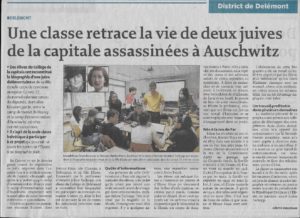
Contributor(s)
Amélie, Aymeline, Chloé, Elena, Gaëtan, Isabella, Jules, Jules, Kali, Kalyssa, Luc, Mathieu, Thalia, Timo, Zaira, students of class 11’2 at Delémont High School, Switzerland, with the guidance of their teachers Mr. Julien Tschopp and Ms. Marilyn Fazio.


 Français
Français Polski
Polski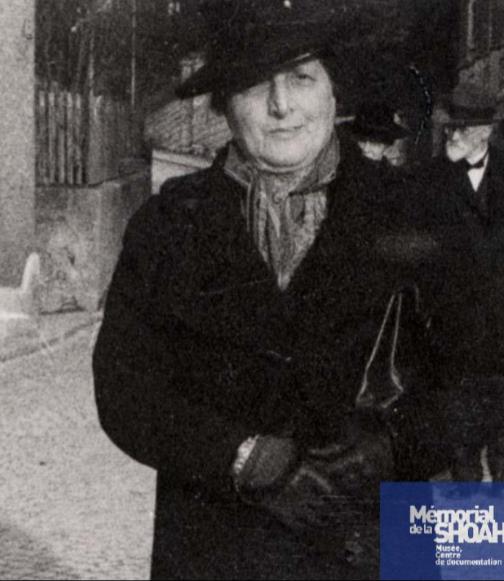










Magnifique ! Votre travail est extraordinaire. L’idée de participer au projet est remarquable, vos recherches aussi, et le texte d’introduction poignant. L’histoire est fondamentale pour permettre (peut-être, il ne faut jamais être sûr de rien) de ne pas rééditer les erreurs du passé.
Merci à vous toutes et à vous tous. Le silence est une seconde mort. Vos travaux nous restituent la présence de Madame Haas et de sa fille, Eliane. Dans vos textes, elle revivent et ils ravivent leur souvenir. Deux victimes innocentes de la barbarie nazie, mortes assassinées, parmi des millions. Ne jamais oublier.
Bonjour, tous mes meilleurs voeux pour cette nouvelle année.
Merci beaucoup pour ce travail. Cette famille fait partie de l’ascendance de mon gendre, il n’en connaissait pas l’existence.
Lorsque je lui ai transmis les liens, il est très vite allé consulter. Il en a appris plus en un temps de lecture que de toute sa vie. Pierre ULMANN est son grand-père maternel.
Je vous remercie toutes et tous pour ce formidable travail.
J’aime à citer quelques mots d’une chanson de Jean FERRAT dans Nuit et Brouillard:
” L’ombre s’est faite humaine, aujourd’hui c’est l’été
Je twisterais les mots s’il fallait les twister
Pour qu’un jour les enfants sachent qui vous étiez”
Merci beaucoup.
Cher monsieur Nallet,
votre message nous réchauffe le cœur.
Bien à vous et meilleurs vœux à vous aussi et à ceux qui vous sont chers.
Chères et chers Amélie, Aymeline, Chloé, Elena, Gaëtan, Isabella, Jules, Jules, Kali, Kalyssa, Luc, Mathieu, Thalia, Timo, Zaira,
C’est avec beaucoup d’émotion et d’intérêt que nous avons lu votre magnifique travail. Vous vous souviendrez sans doute longtemps de cette plongée dans l’histoire du 20e siècle et de ses pages sombres. Vous aurez aussi des arguments solides pour répondre aux négationnistes qui sévissent jusqu’en Suisse. Jeanne vous accompagnera toute votre vie, la lettre bouleversante que vous lui adressez en témoigne.
Nos félicitations vont aussi à vos enseignants, en particulier à Julien Tschopp. Nous l’avions rencontré lorsque nous avions accompagné Noëlla Rouget, qu’il avait invitée à venir témoigner à Delémont. Noëlla Rouget était française et suissesse par mariage. Elle avait été résistante à Angers et déportée à Ravensbrück, d’où elle était heureusement revenue. Nous avons écrit sa biographie, parue en juin 2020 aux éditions Tallandier, sous le titre “Noëlla Rouget la déportée qui a fait gracier son bourreau”. Noëlla est décédée à Genève le 22 novembre dernier, elle avait presque 101 ans. Elle a marqué profondément notre vie, comme Jeanne a marqué les vôtres.
Chers tous , bravo pour cette histoire que j’aimerais publier avec votre autorisation dans le bulletin du cercle d’histoire de Hégenheim et environs ainsi que sur le site du Judaïsme en Alsace. Daniel et Eve Ulmann (née Ditisheim) viennent de deux communautés juives du Sundgau, Durmenach et Hégenheim. J’aimerai faire connaitre votre travail en rajoutant quelques notes. Merci
Merci pour votre message, vous avez notre autorisation pour publier notre travail.
Sinon, vous pouvez aussi prendre contact avec moi, via Convoi 77 ou le Collège de Delémont, peut-être aurez-vous des pistes pour nous permettre de retrouver des descendant-e-s de la famille qui pourraient assister à l’inauguration d’une rue Jeanne Hass-Ulmann prévue cet automne à Delémont. Merci.
Bonjour,
Je suis le petit fils de Pierre Ulmann et fils de Martine Ulmann sa fille.Je tenais à vous remercier pour votre travail de recherche sur une partie de mon histoire familiale jusqu’à ce jour méconnue pour moi.
Encore bravo et merci.
Nicolas
Bonjour, merci pour votre message, je transmettrai vos remerciements aux élèves. Sinon, serait-il possible de vous contacter personnellement, avez-vous un courriel ou un autre moyen pour entrer en contact, si bien sûr vous êtes d’accord? Merci.
Julien Tschopp
C’est avec émotions que j’ai lu le travail réalisé par votre classe.
Un vrai travail de mémoire dont vous pouvez tous être très fier.
Je vais le faire lire à mon petit-fils.
J’espère que notre Président de la République pourra renouveler son invitation du 27 janvier dernier.
Merci.
Jocelyne
[…] normale, si elle avait vu le jour à une autre période. » A l’âge de 65 ans, Jeanne Haas-Ulmann a été arrêtée à Lyon en 1944 puis déportée, avec sa fille Eliane, à Auschwitz. Baptiser une […]
[…] Tschopp et ses élèves du collège de Delémont, en Suisse ont travaillé sur la biographie de Jeanne Haas, arrêtée à Lyon à l’âge de 65 ans. Ce travail fait partie des onze projets européens […]